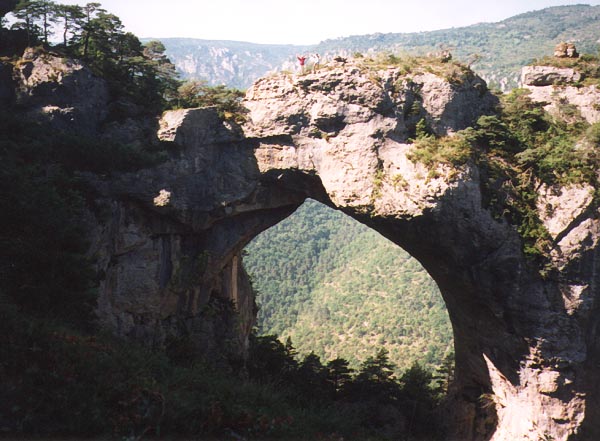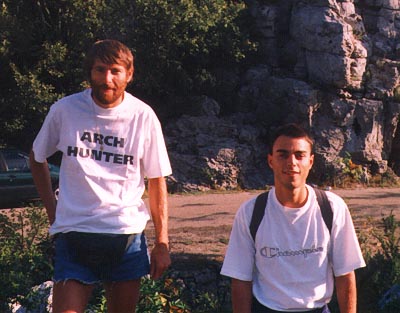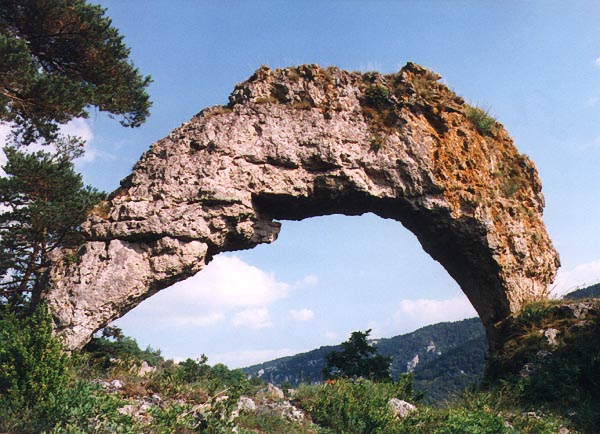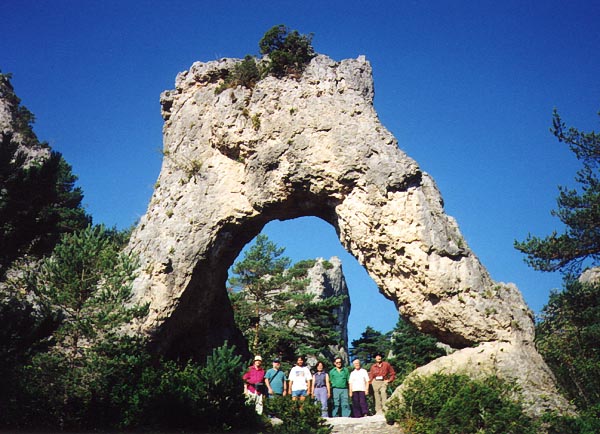
| Figure 16: The editor and guide stand jubilant above the apex of Bous del Biel (FR-6). Photo by Bien Brandt-Erichsen. |
A GRAND TIME IN THE GRANDS CAUSSES
by Quentin Burke
photos by David Brandt-Erichsen (editor)
From SPAN October 1999
We had joy, we had fun, we had arches in the sun
(plus a few in a light rain)....
The scene might have been on a highway in Utah - eight archers, after nine great days of arching, reluctantly parting ways and heading off in different directions on a sunny September morning.
But September 11, 1999 was different. The scene was in southern France, and the archers who were parting ways on Highway N88 were headed for other parts of Provence, for Switzerland, for England, and for the U.S. It was the last day of the first international convention for NABS.
While the trip didn't attract as many takers as our usual conventions (only nine NABS members attended including the two guides), all agreed that they had a great time and what the group lacked in numbers it more than made up in enthusiasm and congeniality. As we took off in our different directions, we carried with us wonderful memories to be relived by the many photos we had taken - umpteen of which "would make a great cover picture for SPAN."
Among the highlights:
|
Guilain Debossens was the driving force that made the convention such a success. We came to think of him as "the French Chris Moore" because he has not only logged over 300 arches in France, but he is also an excellent guide and trip leader. His daily agenda mixed trail walking with occasional creek-wading and more frequent cross-country scrub-bashing, so we were never bored. On a couple of days he even arranged for several French beauties to be sunbathing au naturel on a riverside rock as we filed by. There were enough arches (we visited 65 in all) to keep us on our toes trying to remember "What was that arch in the clearing that we saw yesterday?" And by the end of the trip a few of us even knew how to pronounce the guide's name.
Guilain was aided by his younger partner Alexandre Oulevey, a college student and fellow canyoneer (Figure 13). Alex helped as a translator and acted as tailguide, ever-helpful and courteous with everyone, and especially patient with those of us who "might be old - but we're slow!" Participants in addition to Debossens and Oulevey were David and Bien Brandt-Erichsen (AZ); Quentin and Ellen Burke (CA); Ken Barker (CO); Jay Wilbur (TX); and Ray Millar (U.K.).

Figure 13: Guilain in his "Arch Hunter" T-shirt, and Alex.
This rundown on the trip is not intended to cover all the arches or their statistics. Those facts and figures can be found in SPAN for July-October, 1998. It is rather intended to provide the reader with an overview of the fun time members had on this, our first international outing.
Most of the group gathered at Marseilles Airport on the morning of Thursday, September 2, and boarded our rental cars for the drive to the first stop, Vallon Pont d'Arc, reached after a scenic drive up the sinuous and scenic Ardeche River. The Pont d'Arc spans the river and is the largest natural bridge in Europe (192 feet). It is certainly a unique bridge, spanning a full-fledged, year-round river. With our hotel nearby, we were able to change into swimsuits and sample a rare experience - floating under a natural bridge.
During the night, the starlit sky under which we had dined changed to clouds, and those who figured to take pictures of Pont d'Arc "in the morning" regretted their folly. The climb to the top of the bridge, and a smaller but still good-sized arch, was made in misty rain, but was rewarding for the view up and down the river. We then proceeded to the Bois de Paolive where the L'Ours et Le Lion, an arch that resembles a bear fighting a lion, is a local landmark. Nearby was "Le Labyrinthe" of narrow paths between limestone outcrops where there were seven arches of varying sizes, including a "Fairy Bridge" and the "Gate of Augustin." We walked in light, intermittent rain, which, along with the Spanish moss hanging from the trees, added to the atmosphere in the labyrinth.
Nearby was the Hotel Mais de L'Espaire, the most elegant of the hostelries at which we stayed. The hotelier met us at the door with a bunch of keys and parceled them out to the respective occupants of the rooms we'd booked, smilingly telling us not to worry about tromping mud through the tiled halls. L'Espaire also provided the most elegant dining of the trip, even though it did take the longest (2-1/2 hours) to be served. Your faithful scribe found that his medallions of pork under chestnut sauce, attractively served up with a spiced pear and tiny string beans wrapped in bacon, were absolutely delicious. Jay tried for the "full course" meal, but wasn't able to make it through the cheese plate finale. We have to admit, it was a very strange cheese...but his fellow diners polished it off for him.
Next morning dawned bright and sunny, an ideal day for the proposed canoe trip to arches on the Chassezac River. But, Alas! Canoe rental had ceased for the season, due to low water. The trip down the river to view some eight or nine riverside arches was done on foot, with frequent crossings and re-crossings of the river. Some of the arches were holes at the water's edge, another was on the skyline with a beautiful view down the river. Lunch was eaten at the largest cave/arch of the day, which the experts reckoned to have nine openings. We have a feeling there will be a lot of debate about the dimensions of these arches.
Later on, following refreshments on the deck of the campground café where we'd set off, the keenest photographers returned to a jug-handle arch that was not at its best for photos the previous afternoon. Then it was on south some 120 kilometers to Ganges. The route took us through scenic back roads, which we found rather hair-raising, as a motor "Rallye de Cigalos" was in progress. The racers zoomed in and out of the traffic, passing us on the curves in a constant din of noise. Saturday night in Ganges was bustling, and it seemed everyone had come to town for dinner. It was Ken's finest hour. With his distinguished beard, a baseball cap perched on his head, eyes sparkling, and a smile on his face, he looked for all the world like a wealthy local vintner as he directed David into a parking spot in the town square. Imagine the disappointment of a young lady who coyly asked him in French "Do you live around here?" on learning he was just a tourist.
Under overcast skies, we set out on Sunday to the Grand Arc. This is a large natural bridge spanning a deep pothole beside the Lamajou River. With the river level low, it was considerably larger than its usual height above the average water level. There were a lot of walkers about today. Our walk at this point was on one of the many French "GR" (for Grand Route) trails. One word of caution at this trailhead: Park on the left! When we returned, there was an angry note on David's car (in French of course) which stated that the sign prohibiting parking on the right was "very clear!"
Our route now led through less-than-prosperous farmland to the Circque de Moureze, a park dotted with interesting rock formations. Parking by a decrepit vineyard, we walked to three of these formations which contained arches, the most attractive of which was the 17-foot 11-inch "L'Anse" (the Handle). A fragile arch, it did indeed look as if it could be picked up and carried off.
We drove north to Lodeve in rain, and found the town was all closed up for Sunday night. Dinner in the restaurant of the hotel was enlivened by a young waitress who (possibly flustered by Ken's charm?) knocked over a huge floral arrangement.
Leaving Lodeve under overcast skies, we proceeded north, then west towards Bedarieux. We stopped at a bakery and bought a few goodies, then went on to secondary roads to an open rural area. A walk followed across the meadow to FR-146, the six-meter free-standing arch of dolomitic limestone which had graced the cover of SPAN and also the nice T-shirts that Guilain had made especially for the Convention.
Headed north on the N-9 motorway, unsuspecting French motorists were treated to an unusual and probably illegal U-turn through the median strip by the NABS caravan of three automobiles. The interesting procedure was required to facilitate access to a parking spot for the walk to FR-55 and FR-57. We carried our umbrellas on this walk, but really didn't need them in the Scotch mist. These small arches are in the Rajal Des Gorps, a rocky mass to the west of the highway.
We spent the night at Millau, a very picturesque city which was in the lowlands, nested between the higher plateaus or "causses." We were now to climb up into the high country of one of the four Grands Causses of the region. These sparsely-populated high plateaus are known for their wild beauty of undulating hills, old medieval hamlets, and jagged, dolomitic limestone rocks. Our first destination was the Montpellier-le-Vieux Park. Here are two well-known arches: The Gate of Mycenes (Figure 14), and the Arch of Triumph (and also a host of lesser ones). As they are on the tourist route, we visited the main arches first, then embarked on one of the most interesting cross-country scrub-bashes your faithful scribe has undertaken - or, as David would always say - "another typical tourist day in France!" The most remarkable part was that all the trees were covered with moss, and the dead limbs and rocks underfoot were also covered with moss, making the trek "like walking through a fairy bower," as I had put it. After a couple of false starts in this "bower" we came to the attractive double arch FR-71.
Figure 14: The happy group at Porte de Mycenes.
The night was spent in Le Rozier, some 15 km away, down near the confluence of the Tarn and Jonte Rivers. This was to be our home for three nights. We were ready to stay put for a few days, and Le Rozier was an ideal place to do it. A tiny village of narrow streets, with just one small general store, a couple of bars, two hotels, and a post office. Old men played boules in a court beside the street, and elderly ladies sat on chairs outside their front doors to watch the passers by. No banks, no ATMs, and the lone gas station was way out of town.
Wednesday dawned bright and clear and we were soon up on the Causse Mejean walking down another of the "GRs" to the three remarkable Arcs de St. Pierre (Figure 15). In this clearing in the woods were grouped three lovely arches - 36, 22, and 21 feet wide respectively. The trio were in an attractive area of tall pines, which the foresters had thoughtfully trimmed to make things easier for photographers. The GRs are popular with walkers and on this occasion we ran into a group from the Cote d'Azur. Transferring to another section of GR we walked down a cliffside trail to two outstanding arches, both of which we were later to see from below at pullouts on the highway alongside the Jonte River. First of these arches was the very spectacular Bous del Biel, at approximately 20 meters wide and 15 meters high, the second largest arch of the trip (Figure 16 -- top of this page). On the way back, the more energetic of us descended steeply to the Pas de l'Arc, which though only 4 meters wide by 3 meters high, is nonetheless quite spectacular in its setting on the cliff.

Figure 15: Two of the Arcs de St. Pierre (FR-10 & 11).
The highlight of Thursday was the scouting of a new route to Shepherds' Arch. The arch is visible from a pull-off spot on the road from Le Rozier to Meyrueis (D-996) before cutting back west on the narrow (and we mean narrow) road up to Les Herans. Here, we did a reconnoiter westerly past an old farmhouse, and started a scramble down a stony ridge, before the eagle eyes of Guilain spotted the arch a mile away. Returning to the cars, we drove them down a 4WD track that was surely outside the rules and regulations of all French rent-a-car agencies. Stopping at a wide spot in the track, we walked to the high point of the spur and thrashed through two scrubby thickets and across two open areas ... and ... voila ... Shepherds' Arch! This was without a doubt one of the highlights of the trip. Freestanding arches are always photogenic, especially when, like this one, they are on the skyline. Blue sky filled the opening. Yellowish-green lichen which glowed in the afternoon sun covered part of the arch. Down below, by the Jonte River, cars scurried along D-996. Small wonder that no one wanted to leave FR-16. We will long remember Arcade des Bergers (Figure 17).

Figure 17: The idyllic setting nobody wanted to leave -
Arcade des Bergers (Shepherd Arch).
Friday was marked by a pleasant, fairly level walk through woods and open areas. We had all reluctantly packed up and had said our goodbyes to Le Rozier, filling water bottles at the fountain on the main street. Back up the road to Montpellier Le Vieux, we drove down a much worse four-wheel drive road ("never mind the fine print in the auto rental agreement") and picked up the red and white markings of GR hiking trail # 62. On the itinerary was one the guide called Theater Arch. This arch was unusual in that it had two "stage entrances," one on each side of the stage. There was also a squeeze hole that enabled the physically-favored to climb up to the top. On the other side of the trail was another arch which made a sunny lunch-time picnic spot. We literally burned rubber on the drive out. The sign was right: this really was a four-wheel drive road!
In the afternoon, we drove to Severac le Chateau and checked in to the Hotel des Causses. On Saturday there would be only two more arches and we would be parting. After breakfast in Severac, we headed north to the village of La Canourge and on up the hill towards Maleville. Here was a huge, bulky arch right by a precipitous drop into the valley. It was called Le Sabot de Malepeyre (Malepeyre's Wooden Shoe), and was 8 meters wide by 3 meters high. Unfortunately, being only a few feet from the road, it was treated as a garbage dump (and worse) by some. Twenty-four kilometers further we were driving east on N 88 to the village of Le Villaret. A few hundred yards up a hill into a pine forest plantation, was arch FR-145, at 8 meters by 8 meters, one of the largest we'd seen. For an arch of its size, it seemed virtually unknown. Did Guilain learn about it like all the others while "thrashing through the woods looking for arches"? Not this time. He'd been told about this one in a café in Mende (the next city to the east).
We took photos of each of us who was hardy enough to climb to the top of FR-145. Those who didn't try the climb ate blackberries and talked about future travel plans as we waited. Then, back by the side of the road, the 1999 NABS Convention was all but over. The three members of the group who remained to head back to Marseilles, hit the road for Cavaillon, where an arch in the Luberon awaited. (They report no problem getting to arch FR-133 except that the "designated parking" area was now a "no parking" area - and there was no other place to park!) The rest of us went our different ways. In the case of your faithful scribe and his wife, that route took us to Switzerland - where we got a line on a nice arch, of which more another time.
| Editor's note: Those of us who attended will never forget the guide's expertise and kindness in conducting this trip. As a small token of our appreciation, we presented Guilain with a plaque which included the NABS "Delicate Arch" logo and read as follows: |
|
|
| Directions to Shepherd Arch: Guilain provides these directions to Arcade des Bergers (Shepherd Arch). From Le Rozier (main street) drive east on road D996 into Jonte Canyon to La Caze for seven km and turn left on road D63. Drive up this road 10.7 km and turn right (south) toward La Retournade. Drive this little road 2.8 km and turn left toward Les Herans. Drive to this hamlet at the end of the paved road and proceed 1 km by dirt road (passable for all cars) to the abandoned hamlet of Les Horts. At this point you will make a very sharp left turn at the yellow sign indicating La Jonte-Meyrueis. However, it is best first to proceed on the main dirt road for another km and then scout the area with binoculars below and to the left until you spot the arch. This way you can scout the route. Back at the aforementioned turn, drive down this 4WD road (passable with passenger car going slowly) for 1 km to a spot where you can turn around and park at a point where a rough old road goes very sharply down to the right. Then continue on the main road by foot (south) for about 350 meters to the obvious curve to the left. From here look down the slope to the southwest along a very blunt ridge to a clearing on a promontory. Bushwhack down the slope to the small meadow (about 200 meters). Once you are here, find your way south through rock masses and a grove across the promontory, descending three level terraces to the splendid arch sitting on the side of the cliff. You will in all likelihood have the arch to yourself. |
